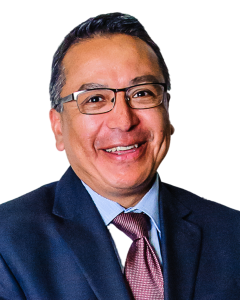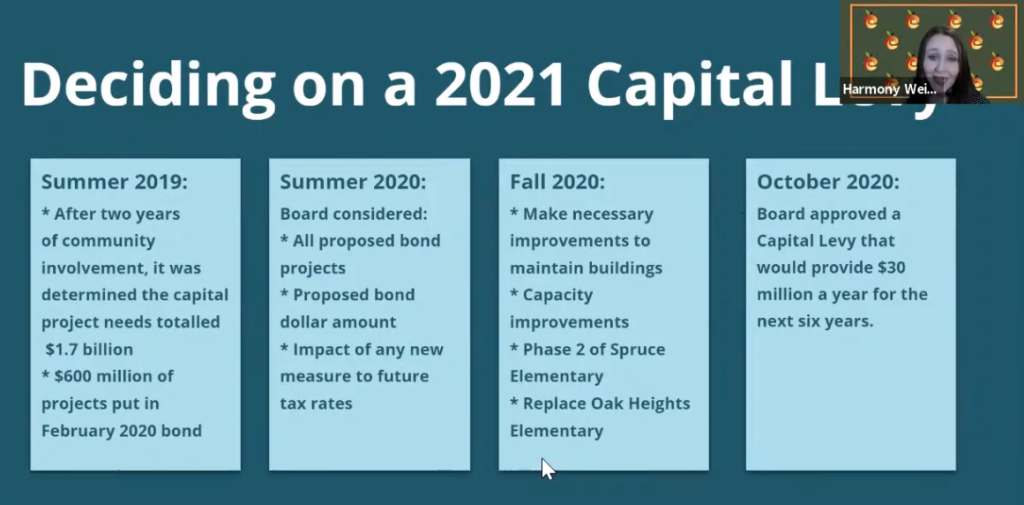By Bo John Brusco | Lynnwood Times Reporter
The Edmonds School District (ESD) had its 2021 Capital Levy forum last Tuesday via Zoom. Dr. Gustavo Balderas, the District’s Superintendent, spoke about the current plan to get students back in their classrooms. Harmony Weinberg, the District’s Program Manager, made a case for the capital levy, citing the urgent structural, safety, and capacity needs.
School Reopenings and Future Plans

Before the presentation, Superintendent Balderas gave a brief update on the school’s reentry plan. He stated that as of Monday, March 29, 2021, students from kindergarten to second grade are back in the classroom and that the schools have been operating according to a hybrid format. Additionally, he stated that the rest of the elementary school students would be back in the classroom beginning on April 12, with all secondary students returning on April 19. Every grade will be following a hybrid format.
Mindful of how challenging this school year has been, Supt. Balderas also mentioned the District’s plan for a robust summer program. He said that the program would be “for learning recovery and acceleration for our students and to plan for fall reentry as well.”
A Simple Concept
After Supt. Balderas’s remarks, Harmony Weinberg, the District’s Program Manager, showed a student-made video called “2021 Capital Levy – According to Students.” The minute-long video features two young students who teach that a Capital Levy is something that “raises money to take care of our schools!” With that money, the students say that “necessary improvements” will be made to address “capacity challenges.”
They also share that the capital levy would be needed to “replace two very, very old schools,” referring to Oak Heights and Spruce Elementaries. At the end of the video, the students remind viewers to “vote before April 27!”
The Four Focus Areas
Beginning to make a case for the 2021 Capital Levy, Weinberg succinctly stated, “We need to invest in our students.” Weinberg then made an important note about the absolute need for a capital levy, stating that “the state does not provide adequate funding for capital facilities, so the law allows districts to ask for local assistance through levies and bonds.”
Weinberg stated that the four main focuses of the levy would be:
- Building improvements
- Safety, security, and accessibility
- Improve capacity
- Replace aging schools
Providing the context for these needs and how they were decided upon, Weinberg explained that in the Summer of 2019, “After two years of community involvement, it was determined that the capital project needs for our district totaled $1.7 billion.” Noting the large sum, Weinberg reiterated, saying, “that’s ‘B’ — billion.”
“It’s important to know,” she continued, “that the two years of this group analyzing and looking at our facilities, these are needs. These are not just new kitchen counters that just will look cute, and you want to get them to look nice. These are specific needs that we really need in our buildings.”

The group Weinberg is referring to is the ESD Facilities Advisory Committee. This committee identified the cumulative capital needs of the district and gave the total estimation of $1.7 billion. Last year, the group prioritized $600 million worth of projects for the February 2020 bond. Voters turned down the bond as it only received 56% support when it needed at least 60% to pass.
Weinberg recounted this failed attempted bond from 2020 and how, after further evaluation, the School Board decided by fall to focus on the four critical needs she mentioned earlier. Come October, “the School Board approved a capital levy that would provide $30 million a year for the next six years,” said Weinberg.
Why now a Capital Levy?
Weinberg noted time as the crucial factor. Not only are students physically returning to school buildings, but as Weinberg pointed out, “The longer we wait, the more it will cost. Prices go up. Costs go up.”
Additionally, Weinberg emphasized that a problem that seems small now will likely become more significant in the future if neglected.
Building Improvements

As “improvements to preserve buildings” is a fairly broad topic, Weinberg provided the specific issues that need to be addressed. She cites roofs and gutters, boilers, building exteriors, and HVAC systems as all requiring repair and improvement.

Weinberg presented a photo of College Place Elementary School’s old cracked roof so that viewers could see for themselves. “If we don’t replace it soon, it will continue to cause costly maintenance issues,” said Weinberg.

A photo of an old boiler from Cedar Way Elementary school. The boiler is the original one from when the school was built in the 1950s. “That is not a picture from a history book,” she said, “that is the current boiler, and a capital levy would allow for a new and energy-efficient boiler at that school.”
Safety, Security, and Accessibility
Two photos depicting an outdated boiler and 30-year-old heating, ventilation, and air conditioning (HVAC) system were used to illustrate the need to address current safety issues. Currently, Meadowdale Elementary, Seaview Elementary, Cedar Valley Community, Cedar Way Elementary, Maplewood K-8, Chase Lake Community, Mountlake Terrace High School, and Terrace Park Elementary all require HVAC system replacements or improvements.

Thirteen schools require critical fire alarm and sprinkler system upgrades. Additional improvements will be made to fencing, gates, and signage. The capital levy would also be used to fund automatic door opening capabilities district-wide for students with physical challenges.
Capacity Challenges
According to Weinberg, elementary schools are at 107% capacity. She also noted that the 44 relocatables — portable classrooms — spread across the District, still do not satisfy current capacity needs.
“This overcrowding exists now and will likely continue with future growth and enrollment,” said Weinberg.

In addition to increasing classroom capacity, the levy would also increase cafeteria and play-area capacity by building more covered areas. “This isn’t just to keep kiddos out of the rain because this is the Northwest,” said Weinberg. “It’s more to allow the district to deal with bigger capacity issues which are shared gym and cafeteria space, and just not having enough areas for our kids at some of our elementary schools because of the capacity challenge.”
Replace Aging Schools
As was mentioned in the video shown at the beginning of the forum, the two schools that stand in the most need of replacement are Oak Heights and Spruce Elementary. Weinberg noted that Spruce Elementary is in particular need of replacement.

“Not only is it an old building,” she said, “But it’s just not built for today’s safety and security needs as well.”
Weinberg shared that the inability of the staff to visibly identify people as they approach the school because the main office lacks windows, is both a safety and security issue for Spruce Elementary.
Tax Dollars and Sense
Showing a graph of annual tax rates, she conveyed that taxpayers were paying almost $2 more per $1,000 three years ago when compared to today. By 2023, the tax rate will still be $1.44 less than what residents were paying in 2018.

If the capital levy receives approval by voters come April 27, the tax rate will be $3.36 per $1,000. Earlier this year, the district made a public statement regarding this tax rate.
“This is lower than what voters have approved in the past and would maintain a steady local education tax rate over the next four years,” said the district.
Weidberg reminded viewers of the why behind this levy. “Who benefits from the 2021 capital levy?” she asks. “Our students! Our Staff! Our Families! Our Community!”
Additional Information
The Edmonds School District maintains transparency when it comes to tax dollars, devoting a page on their website to it, titled Your Tax Dollars at Work.
Anyone who was unable to attend the forum can watch a recording of it on YouTube.com. While the “Q and A” portion of the video is not featured in the recording, Weinberg encourages anyone who has questions to visit the District’s website, edmonds.wednet.edu, and click on the “Questions / Feedback” tab to send the District a message.
Author: Lynnwood Times Staff










3 Responses
What did Edmonds School District do with all the money they saved during COVID 19 closure? They did not pay for bus transportation including drivers on most routes, their utility bills were minimal including trash pick up, teachers’ aids were not needed, which should have saved a significant amount of money. With all these savings, they are asking us to sacrifice and give them more money, I would like full disclosure on their projected vs actual budget for 2019-2020 and 2020-2021 school years. I want to know where our hard earned money went.